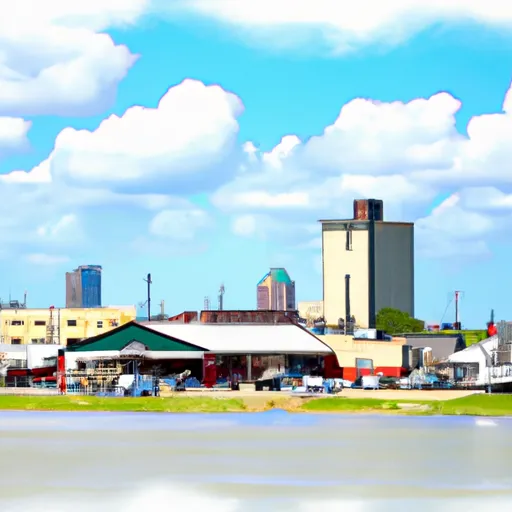-
 Snoflo Premium
Snoflo Premium
Get unlimited access to all our content
With no Ad interruptions! - Start Your Free Trial Login with existing account
Port-Neches
Eden Index
Climate
6.9
•
Recreation
3.1
•
Community
3.2
•
Safeguard
4.6/10

Port Neches is a charming city located in Jefferson County, Texas, with a population of approximately 13,000 residents. The city enjoys a subtropical climate, characterized by hot and humid summers and mild winters. Summers in Port Neches can be quite hot, with temperatures reaching the high 90s°F (30s°C), while winters are usually mild, with temperatures averaging in the 60s°F (15-20°C).
Situated near the Neches River, Port Neches benefits from its hydrology constituents. The river provides a vital water source for the city, supporting various industries and recreational activities. Fishing enthusiasts can enjoy angling for freshwater species such as catfish, bass, and crappie, while boating and kayaking opportunities abound along the river.
Outdoor recreation opportunities in Port Neches are plentiful. The city offers numerous parks with walking trails, picnic areas, and playgrounds for families to enjoy. Oak Bluff Memorial Park is a popular spot, providing stunning views of the river and opportunities for birdwatching. Additionally, golf enthusiasts can tee off at the nearby Babe Zaharias Golf Course, offering a challenging 18-hole course.
Overall, Port Neches, Texas, boasts a favorable climate, thriving hydrology, and a range of outdoor recreation opportunities, making it an attractive destination for residents and visitors alike.
What is the Eden Index?
The Snoflo Eden Index serves as a comprehensive rating system for regions, evaluating their desirability through a holistic assessment of climate health, outdoor recreation opportunities, and natural disaster risk, acknowledging the profound impact of these factors on livability and well-being.
Climate Health Indicator (CHI): 6.9
Port-Neches receives approximately
1477mm of rain per year,
with humidity levels near 90%
and air temperatures averaging around
21°C.
Port-Neches has a plant hardyness factor of
9, meaning
plants and agriculture in this region tend to thrive here all year round.
By considering the ideal temperature range, reliable water supplies, clean air, and stable seasonal rain or snowpacks, the Climate Health Indicator (CHI) underscores the significance of a healthy climate as the foundation for quality living.
A healthy climate is paramount for ensuring a high quality of life and livability in a region, fostering both physical well-being and environmental harmony. This can be characterized by ideal temperatures, reliable access to water supplies, clean air, and consistent seasonal rain or snowpacks.
Weather Forecast
Streamflow Conditions
Neches
Area Rivers
Neches
Snowpack Depths
Neches
Reservoir Storage Capacity
Neches
Groundwater Levels
Recreational Opportunity Index (ROI): 3.1
The Recreational Opportunity Index (ROI) recognizes the value of outdoor recreational options, such as parks, hiking trails, camping sites, and fishing spots, while acknowledging that climate plays a pivotal role in ensuring the comfort and consistency of these experiences.
Access to outdoor recreational opportunities, encompassing activities such as parks, hiking, camping, and fishing, is crucial for overall well-being, and the climate plays a pivotal role in enabling and enhancing these experiences, ensuring that individuals can engage in nature-based activities comfortably and consistently.
Camping Areas
| Campground | Campsites | Reservations | Toilets | Showers | Elevation |
|---|---|---|---|---|---|
| Sandy Creek - Town Bluff Reservoir | 70 | 112 ft | |||
| San Augustine - Sam Rayburn Reservoir | 100 | 194 ft | |||
| Claiborne West Park | None | 16 ft | |||
| Rayburn - Sam Rayburn Reservoir | 70 | 183 ft | |||
| Village Creek State Park | 41 | 36 ft | |||
| Ebenezer - Sam Rayburn Reservoir | 30 | 192 ft | |||
| Red Hills Lake | 26 | 374 ft | |||
| Twin Dikes - Sam Rayburn Reservior | 45 | 198 ft | |||
| Martin Dies State Park | 225 | 88 ft | |||
| Mill Creek - Sam Rayburn Reservoir | 110 | 181 ft |
Nearby Fishing
Nearby Ski Areas
Catastrophe Safeguard Index (CSI):
The Catastrophe Safeguard Index (CSI) recognizes that natural disaster risk, encompassing floods, fires, hurricanes, and tornadoes, can drastically affect safety and the overall appeal of an area.
The level of natural disaster risk in a region significantly affects safety and the overall livability, with climate change amplifying these risks by potentially increasing the frequency and intensity of events like floods, fires, hurricanes, and tornadoes, thereby posing substantial challenges to community resilience and well-being.
Community Resilience Indicator (CRI): 3.2
The Community Resilience Indicator (CRI) recognizes that education, healthcare, and socioeconomics are crucial to the well-being of a region. The CRI acknowledges the profound impact of these elements on residents' overall quality of life. By evaluating educational resources, healthcare accessibility, and economic inclusivity, the index captures the essential aspects that contribute to a thriving community, fostering resident satisfaction, equity, and social cohesion.

